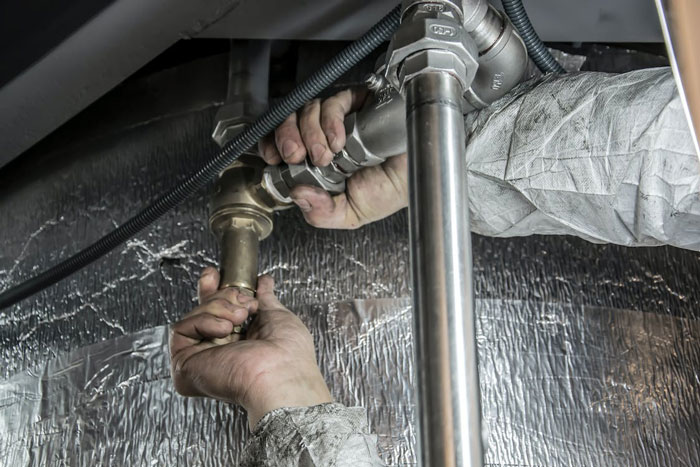
This post provides detailed information on the pipefitter job description, including the key duties, tasks, and responsibilities they commonly perform.
(You will be able to download the Pipefitter job description template in pdf below.)
It also highlights major requirements that you may be expected to meet to be hired for the pipefitter role.
What Does a Pipefitter Do?
Pipefitters are artisans responsible for the layout, assembly, installation, and maintenance of piping systems.
The pipefitter job description entails designing and assembling piping structures used in conveying chemicals, steam, and hot liquids at industrial, commercial, and residential properties.
In performing their duties, pipefitters use saws, cutting torches, and pipe threaders to cut, thread, and hammer pipes to desired specifications.
They weld, solder or cement joints on pipes and pipe fittings to assemble and secure pipes.
They also attach pipes to fixtures, such as tanks by means of clamps, brackets or welding equipment.
The role of pipefitters usually involves collaborating with project managers to design the layout for a pipe system.
They go over a project plan and construction blueprint to fully understand pipefitting requirements.
They also ensure operations are in accordance with building codes, policies, and safety standards.
As part of their work description, pipefitters oversee the selection and procurement of hangers, supports, hydraulic cylinders, and other necessary construction materials.
They are responsible for resolving pipe issues such as clogs or leaks.
They also utilize pump machines to remove water from flooded basements and manholes.
Usually, pipefitters modify, clean, and maintain pipe systems, fittings, and related equipment.
They utilize specialized hand/power tools in removing and replacing worn out components.
They also conduct inspections to ensure pipelines are correctly installed and are efficient.
Pipefitters use rules and scribers to measure and mark pipes for cutting and threading.
They also usually conduct research to determine the type of pipe most suitable for the transportation of hot, acidic or alkaline substances.
They also oversee the installation of gasfitters, steamfitters, and sprinkler fitters for hospitals, factories and residential buildings.
To work as a pipefitter requires a high school diploma which is also a prerequisite for entering into a technical school, or into an apprenticeship program.
The qualities mainly needed for success as a pipefitter include mechanical skills, physical strength, and troubleshooting skills.
Pipefitter Job Description Example/Template
The various tasks, duties, and responsibilities commonly performed by pipefitters are shown in the job description example below:
- Use saws, cutting torches, and pipe benders to cut and hammer pipes to specification
- Study blueprint and construction plans for pipe systems, supports, and related equipment
- Assemble and secure pipes, tubes, and fittings by means of welding, brazing, soldering and cementing of joints
- Utilize pressure gauges and hydrostatic testing to inspect and test installed pipe systems
- Electroplate non-ferrous piping materials with tin and lead to obtain an alloy that prevents erosion
- Operate pump machines to discard water from flooded facility floors, manholes and basements
- Prepare cost estimates and budgets for a pipefitting project
- Install and test water systems such as treatment, recycling, and irrigation systems
- Design equipment and systems to reduce water and energy consumption
- Inspect work sites to identify environmental hazards that can limit the integrity of a pipe structure
- Utilize valve keys and wrenches to regulate liquids, steam and other gaseous substances from pipes
- Oversee the repair and replacement of damaged or worn out pipe components
- Use hand or power tools to drill holes in structures such as wall, decks to allow for pipe passage
- Select pipe types, sizes and quantity required for a pipefitting project
- Install and configure automatic pipe control systems.
Requirements – Skills, Abilities, and Knowledge – for Pipefitter Role
If you are interested in the job of a pipefitter, here are major requirements you should prepare to have as most employers usually insist on them:
- Education and Training: To become a pipefitter, you require a high school diploma which is an entry qualification into a technical school or a pipefitting apprenticeship program where courses on pipe design, safety, and welding are taken. The apprenticeship program lasts a period of 4-5years and is supervised by experienced pipefitters. State licensure is usually required to practice as a professional pipefitter and it can be obtained by passing pipefitting trade examination.
- Mechanical Skills: Pipefitters are able to utilize and operate a range of tools and equipment in installing, maintaining, and repairing pipe systems
- Physical Strength: They are able to handle, lift, and move heavy pipes, pipefitting materials and equipment
- Troubleshooting Skills: They are skilled in diagnosing pipe systems to identify and fix problems with leaks and clogs
- Assessment tests: If you are applying for a pipefitter apprenticeship program or a job, you may likely be asked to take an assessment test. Find out about job assessment tests and how to make top scores in them.
Download pipefitter job description template (pdf).
Conclusion
This post provides a complete pipefitter job description sample that employers can apply as a template to easily and quickly create a work description for the role in their business.
Having a comprehensive job description increases your chances of attracting the best pipefitters to your company when you are hiring.
This post is also valuable to individuals who are interested in the position and are seeking to learn about it.
The functions of the position highlighted in this article will help such people to know more about the pipefitting job and to decide if that’s the career they want to get into.




